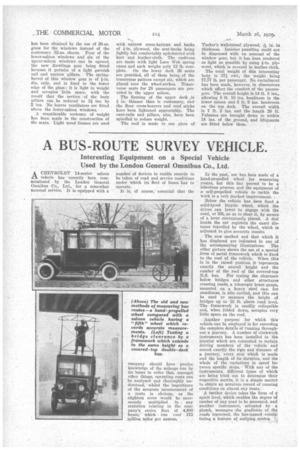A LIGHT DOUBLE-DECKER for LONDON
Page 65

Page 66

If you've noticed an error in this article please click here to report it so we can fix it.
Birch Bros., Ltd., Produces a 54-seater Incorporating Several Interesting Features to Save Weight.
ASSIDLTOUS attention is being paid to the task of producing bus bodies capable of accommodating the largest possible number of passengers in face of the regulations of local authorities governing the maximum laden weight of stage motorbuses. In London, where large carrying capacity is demanded to cope with the morning and eveningtraffic, every suitable means is resorted to for the reduction of body weight, and a vehicle which is of particular interest in this respect has just been completed at the Notth London works of Birch
Bros., Ltd. . .
The objective of the designers has been to produce, within the Scotland Yard. limit og 9 tons laden weight, a 54-seater, bus with a covered upper deck, and the attajnment of this result reflects credit upon the staff of this bodybuilding and bus-operating concern. An inspection of the vehicle on the day of its registration at Scotland,;Xard revealed several of the imPortant' factors contributing to the low -unladen weight.
The chassis is a Dennis la-type with upswept frame, and is shod with 38-in. by 7-in. pneumatic tyres, twin tyres being fitted on the rear wheels. The bod3r framework has been executed in ash, the joints being suitably strengthened by. melded steel brackets, and the
panelling has been carried out in 18gauge sheet aluminium. Where the use of sheet steel was unavoidable—for instance, in the staircase band—the em ployment of 18-gauge metal has been rendered possible by swaging and by wiring the edge of the panel.
Another important saving in weight
has been obtained by the use of 26-oz. glass for the -windows instead of the customary 32-oz. sheets. Four of the lower-saloon windows and six of the upper-saloon windows can be opened, the new Rawlings gear being fitted because it permits of a light garnish rail and narrow pillars. The springbarrel of this window gear is of 4-in, slia. only and is fixed to the lower edge of the glass; it is light in weight and occupies little space, with the result that the section 'of the body pillars can be reduced to n ins. by 2 ins. No louvre ventilators are fitted above the lower-saloon windows.
A considerable economy of weight has been made in the construction of the seats. Light wood frames are used
with narrow cross-battens and backs of i-in. plywood, the seat-backs being lightly but comfortably upholstered with hair and leather-cloth. The cushions are made :with light Lace Web spring eases and each weighs only 12 lb. complete. On the lower deck 26 seats are provided, all of them being of the transverse pattern except six, which are placed over the wheel-arches. Transverse seats for 28 passengers are provided in the upper saloon.
The flooring of the upper deck ,is in. thinner than is customary, and the floor cross-bearers and roof sticks have been lightened appreciably. The cant-rails and pillars, also, have been spindled to reduce weight. . The roof is made in „one piece of
Tucker's waterproof plywood, 136 in. in thickness. Interior panelling could not be dispensed with on account of the window gear, but it has been rendered as light as possible by using 1,-in. plywood, which is covered in leather-cloth.
The total weight of this interesting body is 37i cwt., the weight being 77.77 lb. per passenger. No curtailment has been made however, in dimensions which affect the, comfort of the passengers. The overall height is 14 ft. 8 ills., allowing 5 ft. 10 ins, headroom in the lower saloon and 5 ft. 9 ins, headroom on the top deck. The overall width is 7 ft. 2 ins, and the length 26 ft. Valances are brought down to within 18 ins, of the ground, and lifeguards are fitted below them.




























































































































